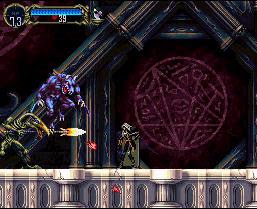
Nintendo loves their franchises. Despite being formulaic and derivative, many of their in-house productions are released to commercial and critical success. The worst victim of
Nintendo's reliance on franchises is the Zelda series, which has never seen any real reinvention. Mario had the transition to 3D,
Metroid had the transition to 1st person, and Star Fox got to run around on land, but Link's been doing the same thing since he first swung his sword on the
NES in 1986.
Don't get me wrong; I
love the Zelda series. I think each new game, as much material as they take from previous games, offers something new and exciting that keeps me coming back for more. It was an interesting experience, though, to go back and play
A Link to the Past, since much of the formula for the plot of most console Zelda games is derived from it. The items, the 3-dungeons-then-7-dungeons device, and even the music in the contemporary series entries date back to this
SNES title. I am ashamed to say that this was my first
playthrough of the classic, though I had been exposed to the game many times before.
A Link to the Past starts out with the player taking control of the character Link, who has woken from a dream about needing to rescue a princess to find that his Uncle is preparing for battle. Ignoring his Uncle's command to stay in bed, Link follows him to a castle where he becomes entwined in an evil plot to take over the world by using the
Triforce, an object that grants the wishes of its possessor. Unfortunately, after you defeat
Agahnim, the evil wizard, and he sends Link to the dark world, the plot becomes a little lost in the midst of trying to collect the seven pieces of the
Triforce, and I lost focus because I there was little plot motivation to continue collecting. I would have appreciated an advancing storyline
outside of what we see after collecting each
Triforce piece.
As I expected, the actual game mechanics were polished to perfection. That's a standard for the Zelda series: rarely can you find a control scheme or hit detection to grip about (though horse riding has never really been well done, not even in
Twilight Princess). The enemies are carefully balanced to be just tough enough for the player according to the items they have acquired, and the ability to access new areas by
teleporting from the dark to the light world is absolute genius. There were a few times when I
teleported onto something I shouldn't have, but instead of sending me back, it got me stuck. That was frustrating, but I don't think it's reasonable to expect perfection; players could play through the whole game without every doing what I did.
The use of imagery was appropriate and set the mood for certain areas very well. For example, upon
teleporting back and forth between light and dark worlds in the Lost Woods, the sheer amount of live greens and bright light that shown through in the light world contrasted sharply with the foggy dead feeling of the dark world Lost Woods. The music wasn't as fantastic as I've come to expect from Zelda games, but many of the predecessors to some of the great themes were there:
Kakariko Village, Legend of Zelda Main Theme, and Zelda's Lullaby just to name a few. They were unfortunately limited by the technology they were working with, and I think that they had grand and epic scale intentions for the score that they just couldn't make happen until Zelda reappeared on later consoles. In comparison, Earthbound had no such great aspirations, but rather was able to make music that sounded like it was made for the system, rather than written for an orchestra.
I enjoyed this game, with some reservations. In the latter half of the dark world
plotline, it all got rather old, and so I became bored and focused on beating the game as quickly as possible. Perhaps it's because I don't come from the generation that grew up with this game, but I just don't think it measures up to the bar set by
Zelda 64. However, it is still a powerful game, and one that deserves a
playthrough simply because it is a true piece of history, as the granddaddy of the modern Zelda.
(Rated E for Everyone. Offensive content: None)






